Harnessing the Power of Our Immune Systems to Treat Neuroblastoma: Discovery of Ch14.18 Immunotherapy
Key Points
- Neuroblastoma is a cancer arising in immature nerve cells. It occurs most often in the adrenal glands, but it can also develop in other areas of the abdomen and in the chest and neck near the spine. Neuroblastoma is the most common cancer affecting infants, yet the cause of this rare cancer is unknown.
- Prior to a groundbreaking discovery by scientists supported by the National Cancer Institute (NCI), the majority of children diagnosed with advanced-stage disease had little hope of surviving and less than 40 percent lived five years after diagnosis.
- Now an immunotherapy 30 years in the making called ch14.18 is providing new hope for infants and children with this rare cancer.
Pathway to Discovery
Immunotherapy is a type of treatment that harnesses the power of the immune system to help the body fight cancer, infection, and other diseases. Some types of immunotherapy stimulate or enhance the immune system’s ability to fight disease, whereas others provide the immune system with what it needs, such as antibodies, to fight disease.
In the late 1980s, Alice Yu, M.D., at the University of California, San Diego Medical Center, began testing an approach that used laboratory made antibodies, called monoclonal antibodies, as a treatment for neuroblastoma. Monoclonal antibodies are designed to target a specific protein or cell. Dr. Yu's immunotherapy treatment went through many versions before reaching its current standard, a monoclonal antibody called ch14.18.
The ch14.18 monoclonal antibody specifically targets a substance called GD2 that is found at high levels on the surface of neuroblastoma cells. When the immune system detects the presence of the antibody on the cancer cells, it triggers responses that kill the cancer cells.
Dr. Yu and her colleagues in the Children's Oncology Group, part of NCI’s National Clinical Trials Network, tested the ch14.18 monoclonal antibody on 226 patients with neuroblastoma in 2001. The treatment was given to children who already had responded to initial treatment with chemotherapy, radiation, and stem cell transplantation. The ch14.18 antibody was administered along with two immune-stimulating agents, GM-CSF (granulocyte macrophage colony stimulating factor) and IL-2 (interleukin-2), to increase the effectiveness of immune system killing of the tumor cells.
In 2009, an interim analysis of the clinical trial showed that the treatment was successful. Among patients who received the immunotherapy plus standard treatment, 66 percent were alive and free of neuroblastoma two years later compared with 46 percent of those who had received standard therapy alone. In light of such favorable results during the interim analysis, the immunotherapy was made available to all eligible patients within the study.
Reporting their findings in the New England Journal of Medicine, the researchers concluded that the immunotherapy improved survival in children newly diagnosed with neuroblastoma who were at high risk for developing a recurrence and who responded well to initial treatment with standard therapies.
Enhancing Cancer Care
Before ch14.18 treatment, more than 60 percent of children with aggressive neuroblastoma would not live five years after being diagnosed. The combination of the anti-GD2 antibody and an immune-stimulating treatment is the first effective immunotherapy for neuroblastoma shown to reduce the risk of recurrence and improve survival by 20 percent for patients with high-risk neuroblastoma.
More than twenty years after Dr. Yu began testing this immunotherapy treatment, her concept is an effective standard therapy for high-risk patients in remission following initial disease treatment. Many children are being saved from this disease by harnessing the therapeutic power of their own immune systems.
Turning Discovery into Health
In some children, neuroblastoma recurs within two years of treatment, while others remain tumor-free. Dr. Yu’s team is now looking closely at the immune responses and tumor behavior in these two groups of patients to identify differential biological markers. Identifying the markers that indicate that disease may redevelop could allow clinicians to tailor treatments and make the immunotherapy even more effective.
In addition, researchers are actively developing less toxic versions of the current immunotherapy to reduce side effects, such as nerve pain. In the meantime, patients' nerve pain must be effectively managed by physicians to safely give the treatment.
Building on the success of ch14.18, researchers are using T cells, engineered to express a new class of proteins known as chimeric antigen receptors (CARs), to fight neuroblastoma in a new and more robust immune cell-based treatment targeted to GD2.
Research to Practice: NCI's Role
NCI has supported more than 30 years of research on antibody-based immunotherapy, resulting in scientists bringing a new life-saving treatment to children with aggressive neuroblastoma. This research ranged from the discovery stage to phase III clinical trials that showed the treatment’s effectiveness.
In addition, when no pharmaceutical company was willing to manufacture the anti-GD2 (ch14.18) antibody for the clinical trial, NCI began producing the antibody itself. Once its effectiveness was proven, NCI increased production of the antibody to ensure availability for every child with neuroblastoma who is eligible for the treatment.
Key Takeaway
Prior to the discovery of ch14.18, most children diagnosed with advanced-stage neuroblastoma had little hope of surviving. Thanks to NCI supported-research, many children are now being saved from this disease by harnessing the therapeutic power of their own immune systems.
Selected Resources
Louis CU, Savoldo B, Dotti G, et al. Antitumor activity and long-term fate of chimeric antigen receptor-positive T cells in patients with neuroblastoma. Blood. 2011 Dec 1;118(23):6050-6056. [PUBMED Abstract]
Matthay KK, George RE, Yu AL. Promising therapeutic targets in neuroblastoma. Clin Cancer Res. 2012 May 15;18(10):2740-2753. [PUBMED Abstract]
Navid F, Armstrong M, Barfield RC. Immune therapies for neuroblastoma. Cancer Biol Ther. 2009 May;8(10):874-882. Epub 2009 May 9. [PUBMED Abstract]
Seeger RC. Immunology and immunotherapy of neuroblastoma. Semin Cancer Biol. 2011 Oct;21(4):229-237. Epub 2911 Sept 28. [PUBMED Abstract]
Yu AL, Gilman AL, Ozkaynak MF, et al. Anti-GD2 antibody with GM-CSF, interleukin-2, and isotretinoin for neuroblastoma. N Engl J Med. 2010 Sept 30;363(14):1324-1334. [PUBMED Abstract]


